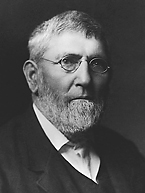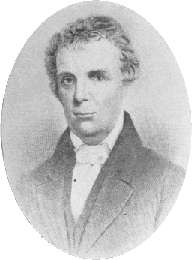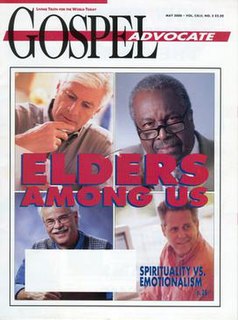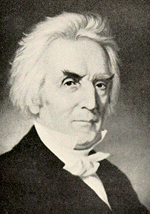
Alexander Campbell was a Scots-Irish immigrant who became an ordained minister in the United States and joined his father Thomas Campbell as a leader of a reform effort that is historically known as the Restoration Movement, and by some as the "Stone-Campbell Movement." It resulted in the development of non-denominational Christian churches, which stressed reliance on scripture and few essentials. Campbell was influenced by similar efforts in Scotland, in particular, by James and Robert Haldane, who emphasized their interpretation of Christianity as found in the New Testament. In 1832, the group of reformers led by the Campbells merged with a similar movement that began under the leadership of Barton W. Stone in Kentucky. Their congregations identified as Disciples of Christ or Christian churches. Several American church groups have historical roots in the Campbells' efforts, including the Churches of Christ, the Christian churches and churches of Christ, and Evangelical Christian Church in Canada, the Christian Church. Alexander Campbell also founded Bethany College in what became Bethany, West Virginia.
Churches of Christ are autonomous Christian congregations associated with one another through distinct beliefs and practices. Represented chiefly in the United States and one of several branches to develop out of the American Restoration Movement, they claim biblical precedent for their doctrine and practice and trace their heritage back to the early Christian church as described in the New Testament.

David Lipscomb was a minister, editor, and educator in the American Restoration Movement and one of the leaders of that movement, which, by 1906, had formalized a division into the Church of Christ and the Christian Church. James A. Harding and David Lipscomb founded the Nashville Bible School, now known as Lipscomb University in honor of the latter.

Barton Warren Stone was an American Evangelist during the early 19th-century Second Great Awakening in the United States. First ordained a Presbyterian minister, he and four other ministers of the Washington Presbytery resigned after arguments about doctrine and enforcement of policy by the Kentucky Synod. This was in 1803, after Stone had helped lead the mammoth Cane Ridge Revival, a several-day communion season attended by nearly 20,000 persons.
William Lipscomb was a leading figure of the American Restoration Movement.

The Gospel Advocate is a religious magazine published monthly in Nashville, Tennessee for members of the Churches of Christ. The Advocate has enjoyed uninterrupted publication since 1866.
Robert Henry Boll was a German-born American preacher in the Churches of Christ. Boll is most known for advancing a premillennialist eschatology within the Churches of Christ, in articles written during his editorship of the front page of the Gospel Advocate from 1909 to 1915 and after 1915 in Word and Work, leading to a dispute which was a significant source of division within the Churches of Christ in the 1930s. Boll was one of the most influential advocates for the premillennial point of view, and was most singularly opposed by Foy E. Wallace Jr. By the end of the 20th century, however, the divisions caused by the debate over premillennialism were diminishing, and in the 2000 edition of the directory Churches of Christ in the United States, published by Mac Lynn, congregations holding premillennial views were no longer listed separately.
The Firm Foundation was a religious periodical published monthly in Houston, Texas, for members of the Churches of Christ. It was established in 1884 by Austin McGary. The Firm Foundation was, for the next hundred years, one of the two most influential publications among the Churches of Christ along with the Gospel Advocate.

Walter Scott was one of the four key early leaders in the Restoration Movement, along with Barton W. Stone, Thomas Campbell and Thomas' son Alexander Campbell. He was a successful evangelist and helped to stabilize the Campbell movement as it was separating from the Baptists.
Word and Work is a religious journal associated with those Churches of Christ that hold to a premillennial eschatology. It was founded in 1908 by Dr. David Lipscomb Watson.
The Christians were a group arising during the Second Great Awakening of the early 19th century. The most prominent leader was Barton W. Stone. The group was committed to restoring primitive Christianity. It merged with the Disciples of Christ in 1832 to form what is now described as the American Restoration Movement
The Disciples of Christ were a group arising during the Second Great Awakening of the early 19th century. The most prominent leaders were Thomas and Alexander Campbell. The group was committed to restoring primitive Christianity. It merged with the Christians in 1832 to form what is now described as the American Restoration Movement.
The Millennial Harbinger was a religious magazine established by the early Restoration Movement leader Alexander Campbell in 1830. Campbell viewed the magazine as an important vehicle for promoting the religious reforms that he believed would help usher in the millennium.

The Christian Baptist, established in 1823 by Alexander Campbell, was the first magazine associated with the early Restoration Movement. The prospectus for the Christian Baptist described its purpose as "[to] espouse the cause of no religious sect, excepting that ancient sect called 'Christians first at Antioch.' Its sole object shall be the eviction of truth, and the exposure of error in doctrine and practice." The style has been described as "lively" and "sarcastic". Campbell discontinued the Christian Baptist in 1830 and began publishing a new journal named the Millennial Harbinger which had a "milder tone".

The Living Oracles is a translation of the New Testament compiled and edited by the early Restoration Movement leader Alexander Campbell. Published in 1826, it was based on an 1818 combined edition of translations by George Campbell, James MacKnight and Philip Doddridge, and included edits and extensive notes by Campbell.
The Christian Messenger was a religious magazine established by the early Restoration Movement leader Barton W. Stone in 1826. The paper was a key means of communication for the "Christians" led by Stone and a primary source of unity in the movement, but consistently struggled for survival. It also played a key role in promoting the merger of the "Christians" with the "Disciples" led by Thomas and Alexander Campbell.
The American Christian Missionary Society (ACMS) was the first missionary organization associated with the Restoration Movement.
The Christian Standard is a religious periodical associated with the Restoration Movement that was established in 1866. The Standard began focusing on a particular branch of the movement, the Christian churches and churches of Christ, in second half of the 20th century and became the most influential of the movement publications among those churches.
The Churches of Christ in Europe are Christian groups of autonomous congregations using the name "church of Christ" which may or may not have a historical association with the Restoration Movement. These groups are characterized by an emphasis on basing doctrine and practice on the Bible alone in order to restore the New Testament church they believe to have been established by Jesus.







